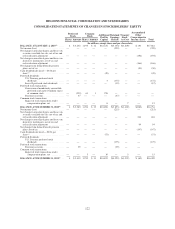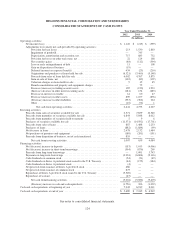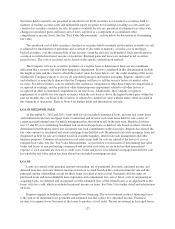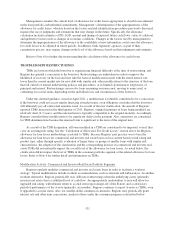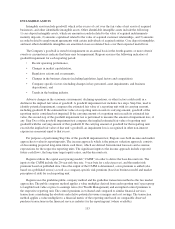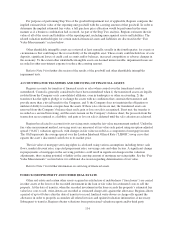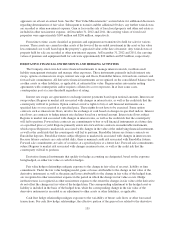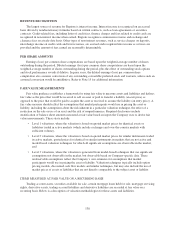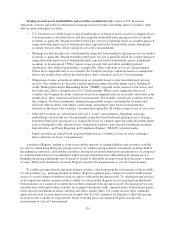Regions Bank 2012 Annual Report Download - page 146
Download and view the complete annual report
Please find page 146 of the 2012 Regions Bank annual report below. You can navigate through the pages in the report by either clicking on the pages listed below, or by using the keyword search tool below to find specific information within the annual report.
Beginning in 2011, these pools were compiled at a more granular level, and the pool-level allowance was based
on the PD and LGD parameters described above. The Company made the change to provide enhanced
segmentation, process controls, transparency, governance and information technology controls. The changes in
the estimation process did not have a material impact on the overall allowance for credit losses or provision for
loan losses.
Consumer Components
For consumer loans, the classes are segmented into pools of loans with similar risk characteristics. For most
consumer loans pools, historical losses are the primary factor in establishing the allowance allocated to each
pool. Regions reviews the historical loss rates for each pool. The twelve month loss rate is the basis for the
allocation; it may be adjusted as a result of any deteriorating trends and portfolio growth.
The allowance for loan losses for residential first mortgage TDRs is calculated based on a discounted cash
flow analysis on pools of homogeneous loans. Cash flows are projected using the restructured terms and then
discounted at the original note rate. The projected cash flows assume a default rate, which is based on historical
performance of residential first mortgage TDRs. The allowance for loan losses for the home equity pool is
calculated based on a twelve-month historical loss rate segmented based on the following risk characteristics:
lien position, status as a TDR, geography, past due status, and refreshed FICO scores for non-past due loans. The
home equity pool was segmented at this more granular level beginning in the first quarter of 2012 as part of the
Company’s ongoing efforts to enhance the allowance calculation and in response to regulatory guidance issued
during the first quarter of 2012.
Qualitative Factors
While quantitative allowance methodologies strive to reflect all risk factors, potential imprecision exists in
the estimation process due to the inherent time lag of obtaining information and variations between estimates and
actual outcomes. Additionally, exposures to industries experiencing various levels of economic stress lead to
losses which are not captured in the statistical models. Regions adjusts the allowance in consideration of these
factors. The allowance calculation also includes factors which may not be directly measured in the specific or
pooled calculations, including:
• Credit quality trends,
• Loss experience in particular portfolios,
• Macroeconomic factors such as unemployment or real estate prices,
• Changes in risk selection and underwriting standards,
• Shifts in credit quality of consumer customers which is not yet reflected in the historical data.
Reserve for Unfunded Credit Commitments
In order to estimate a reserve for unfunded commitments, Regions uses a process consistent with that used
in developing the allowance for loan losses. In the second quarter of 2012, the Company refined the methodology
for estimation of the reserve for unfunded credit commitments. Before the change, the Company based the
reserve for unfunded credit commitments on an analysis of the overall probability of funding and historical
losses. Beginning with the second quarter of 2012, the reserve is based on an exposure at default (“EAD”)
multiplied by a probability of default (“PD”) multiplied by a loss-given default (“LGD”). The EAD is estimated
based on an analysis of historical funding patterns for defaulted loans in various categories. The PD and LGD
align with the statistically-calculated parameters used to calculate the allowance for loan losses for various pools,
which are based on credit quality indicators and product type. The methodology applies to commercial and
investor real estate credit commitments and standby letters of credit. Changes in the reserve for unfunded
commitments are recognized in other non-interest expense.
130




